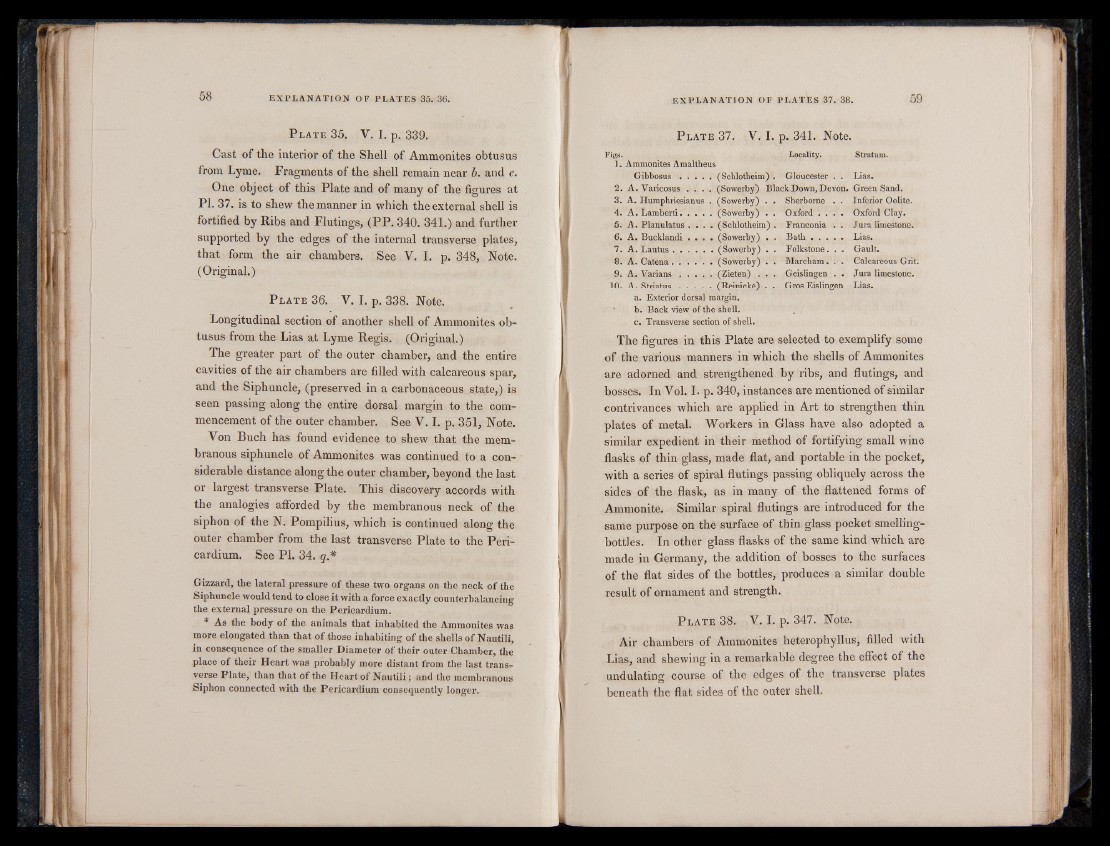
P late 35. V. I. p. 339.
Cast of the interior of the Shell of Ammonites obtusus
from Lyme. Fragments of the shell remain near b. and e.
One object of this Plate and of many of the figures at
PI. 37. is to shew the manner in which the external shell is
fortified by Ribs and Flutings, (PP. 340. 341.) and further
supported by the edges of the internal transverse plates,
that form the air chambers. See V. I. p. 348, Note.
(Original.)
P late 36. V. I. p. 338. Note.
Longitudinal section of another shell of Ammonites obtusus
from the Lias at Lyme Regis. (Original.)
The greater part of the outer chamber, and the entire
cavities of the air chambers are filled with calcareous spar,
and the Siphuncle, (preserved in a carbonaceous state,) is
seen passing along the entire dorsal margin to the commencement
of the outer chamber. See V. I. p. 351, Note.
Von Buch has found evidence to shew that the membranous
siphuncle of Ammonites was continued to a considerable
distance along the outer chamber, beyond the last
or largest transverse Plate. This discovery accords with
the analogies afforded by the membranous neck of the
siphon of the N. Pompilius, which is continued along the
outer chamber from the last transverse Plate to the Pericardium.
See PI. 34. q *
Gizzard, the lateral pressure of these two organs on the neck of the
Siphuncle would tend to close it with a force exactly counterbalancing
the external pressure on the Pericardium.
* As the hody of the animals that inhabited the Ammonites was
more elongated than that of those inhabiting of the shells of Nautili,
in consequence of the smaller Diameter of their outer Chamber, the
place of their Heart was probably more distant from the last transverse
Plate, than that of the Heart of N autili; and the membranous
Siphon connected with the Pericardium consequently longer.
P late 37. V. I. p. 341. Note.
Figs. Locality. Stratum.
1. Ammonites Amaltheus
Gibbosus............ (Schlotheim) . Gloucester . . Lias.
2. A. Varicosus . . . . (Sowerby) Black Down, Devon. GreenSand.
3. A. Humphriesianus . (Sowerby) . . Sherborne . . Inferior Oolite.
4. A. Lamberti............ (Sowerby) . . Oxford . . . . Oxford Clay.
5. A. Planulatus . . . . (Schlotheim). Franconia . . Jura limestone.
6. A. Bucklandi . . . . (Sowerby) . . B a th ............ Lias.
7. A. Lautus................(Sowerby) . . Folkstone. . . Gault.
8. A. Catena . . . . . . (Sowerby) . . Marcham. . . Calcareous Grit.
9. A. Varians . . . . . (Zieten) . . . Geislingen . . Jura limestone.
10. A. Striatus........... (Reinicke) . . Gros Eislingen Lias.
a. Exterior dorsal margin.
b. Back view of the shell.
c. Transverse section of shell.
The figures in this Plate are selected to exemplify some
of the various manners in which the shells of Ammonites
are adorned and strengthened by ribs, and flutings, and
bosses. In Vol. I. p. 340, instances are mentioned of similar
contrivances which are applied in Art to strengthen thin
plates of metal. Workers in Glass have also adopted a
similar expedient in their method of fortifying small wine
flasks of thin glass, made flat, and portable in the pocket,
with a series of spiral flutings passing obliquely across the
sides of the flask, as in many of the flattened forms of
Ammonite. Similar spiral flutings are introduced for the
same purpose on the surface of thin glass pocket smelling-
bottles. In other glass flasks of the same kind which are
made in Germany, the addition of bosses to the surfaces
of the flat sides of the bottles, produces a similar double
result of ornament and strength.
P late 38. V. I. p. 347. Note.
Air chambers of Ammonites heterophyllus, filled with
Lias, and shewing in a remarkable degree the effect of the
undulating course of the edges of the transverse plates
beneath the flat sides of the outer shell.